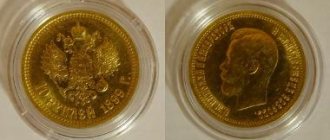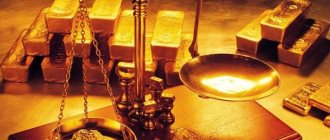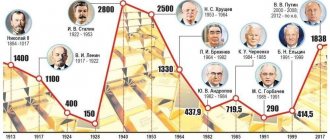What is the gold standard and why is it needed?
The gold standard is a system in which banknotes are backed by a certain amount of gold. In ancient times and the Middle Ages, money was coins made of real gold, silver or bronze. That is, one could talk about metallic money.
Gold and silver occupied the main place in this system, because these metals are precious - they are not subject to corrosion, are chemically neutral, and at the same time ductile, identification can be carried out based on their physical and chemical properties. A metal coin - regardless of mintage - can be weighed and other examination procedures performed, and thus determine its authenticity. For a few of these precious coins you can buy a large amount of goods. At the same time, they are convenient to transport from place to place.
And they don't deteriorate over time. If desired, a gold coin can even be easily divided into small parts. In this case, it will no longer be tied to its denomination and will not be secured by the authority of a specific ruler on whose territory the minting takes place. But the metal itself will not lose its value; it can be sold to jewelers. That is, the use of gold and silver coins in trade and exchange operations is dictated simply by convenience and the desire for standardization.
Gold is more expensive (it is less abundant), so it accumulates more value. It is this that has always played a key role. Silver allows the production of coins for small trade. The silver standard often operated simultaneously with the gold standard. At certain periods of time, bronze coins were also in use. But they were supplanted by gold and silver.
Prospects for the standard in the global economy
The gold standard was of great importance for the development of the economies of individual countries, as well as for understanding the interdependence of states on general trends in the world economy, from which one cannot isolate oneself.
It was the first principles that made possible the emergence of a new economic model for regulating national currencies. By the way, it was during the Bretton Woods Conference that it was decided to create the International Monetary Fund and the International Bank for Reconstruction and Development. The latter is often called the World Bank, which indicates its role and influence on ongoing processes.
The Bretton Woods system existed until the mid-60s, when there was an understanding of the need for further reforms due to changed circumstances.
In the mid-70s, the Jamaican Conference took place, the results of which are still valid today. It was she who finally abolished the gold backing of national currencies, and also abolished the officially established price of gold, which became an ordinary commodity. Its price was regulated by the usual market principles of supply and demand.
From time to time, politicians and economists talk about the need to return to the gold standard, but so far modern economic realities do not allow these plans to be implemented.
History of the gold standard
In a broad sense, the gold standard can be understood as any monetary system in which money is tied to gold. But this system has undergone changes throughout history.
In ancient times, coins made of gold and silver were mainly used. The metal content of coins varied over different periods. Usually their purchasing power depended on this. But what was important was that the coin was made of precious metal. That is, it was valuable in itself. This system is typical of the ancient world. Minted gold coins already existed in the 7th century. BC e., and perhaps earlier. But they were constantly worn out and lost weight over time, so their real value decreased compared to their face value. There were also problems when transporting large volumes.
Over time, in the Middle Ages, money began to appear that did not itself contain any amount of precious metal. But at the same time they could be exchanged for this metal from the state (metal holder). Thus, money became a liability with the right to exchange for gold or silver, and the state power acted as the guarantor of exchange. That is, we are talking about secured currencies with a fixed rate. Typically, paper certificates were used as such money. They were actively used in trade operations. In the event of the fall of power, such money rapidly depreciated. After all, no one could guarantee the right to exchange. And the material from which this money was made was practically worthless. But it was convenient to use paper money.
Why cancelled?
In Russia, the gold standard was introduced in 1897 through the efforts of Witte, whose name was given to the economic reform. At that time, the ruble was backed by 0.774235 grams of gold. Before the outbreak of World War I, the ruble was in first place among gold-backed currencies. However, with the outbreak of hostilities, the exchange of money for gold became impossible, and even the release of gold chervonets did not improve the situation. Industrialization brought an end to the gold standard in Russia. For the same reason or because of inflationary processes, the gold standard ceased to be used in other states.
Attempts to return to him were unsuccessful. As a result of efforts to maintain a stable exchange rate, the Bretton Woods Agreement was signed, according to which the participating countries were endowed with stable exchange rates, and a troy ounce was equal to 35 dollars. National banks were appointed responsible for exchange rates, and revaluation was necessary to change the exchange rate.
Pros and cons of the gold standard
Experts are still arguing which model is better - the previous one, based on the gold standard, or the current inflationary one. In accordance with the latter, the money supply, constantly expanding through lending, covers the commodity supply, and thus a certain balance is formed. Moderate inflation of 2-5% is considered normal and even desirable. For money holders, this is a negative point that was absent under the previous system, when the currency rate was tied to a precious metal. But there are also reasons to abandon the old model. Let's try to determine what pros and cons (in comparison with the current inflation model) the gold standard provided.
Progress of reform
Preparations for the reform began in the 1880s and were caused by the instability of the monetary system. In February 1895, Finance Minister Sergei Witte presented a report to Emperor Nicholas II on the need to introduce gold circulation. Witte decided to introduce the gold standard adopted in England, rather than the gold-silver standard that was formally in force in France.
By the law of May 8, 1895, it was allowed to conclude transactions in gold, at the same time all offices and branches of the State Bank were given the right to buy gold coins, and 8 offices and 25 branches also made payments with this coin. In June 1895, the State Bank was allowed to accept gold coins into a current account (private St. Petersburg banks followed this example); in November 1895, gold coins were allowed to be accepted by the cash registers of all government agencies and state-owned railways. In December 1895, the rate of credit notes was established at 7.40 rubles for a gold semi-imperial with a face value of 5 rubles (since 1896 - 7.50 rubles).
By 1897, the State Bank increased its gold cash from 300 million to 1095 million rubles, which almost corresponded to the amount of banknotes in circulation (1121 million rubles).
On August 29, 1897, a decree was issued on the issuing operations of the State Bank, which received the right to issue credit notes, freely and without restrictions exchangeable for gold.
No samples
The history of the gold standard is as captivating as any other thriller.
Watch
— And the Americans are not afraid that they themselves will go to the bottom with China?
- Apparently not. The desire to burn down a competitor is clearly stronger than other arguments and calculations. The United States views China as its main rival on the world stage. It must be said that American business at one time contributed to the development of the Chinese economy. Trump apparently believes that if Beijing is deprived of American technology, the Chinese miracle will collapse. We realized it too late. Of course, the USA remains the main scientific and technological center of the world. But ten years ago China became concerned about creating its own scientific, university and technological base, equal to the American one. The Chinese actively lured away not even individual professors, but entire scientific and professorial schools, and created their own analogue of Silicon Valley.
— Sustainable economic growth in the modern world is an illusion: economic crises are shaking the world economy more and more often from year to year. This means that you cannot rely on any currency, including the dollar. The search for a replacement has been ongoing for several years now...
— So far, everyone is happy with the dollar, including China: Beijing has even increased its dollar reserves. If it were not for the threat of increased sanctions, it would suit Russia too. Over the past half century, a fairly comfortable financial system has formed in the world: there is a main reserve currency, and this is much more convenient than a multi-currency system, when each country had to be settled in its monetary units. At one time, the same role was played by the British pound, but with the loss of position of the British economy at the end of the Second World War, this function passed to the dollar. And it cannot be said that the dollar is forever. Take, for example, the euro project - also an attempt to create a strong reserve currency on the basis of the strong economies of individual EU countries. The euro rests on only three “pillars” - France, Germany and the Netherlands, but overall shows a positive balance and growth, despite the presence of outsider countries in terms of national GDP growth. And the euro is another reserve currency, albeit inferior in share to the dollar. What will happen next is an open question. If the Chinese economy survives and wins competition from the United States, then the dollar will replace the yuan in its current position.
— Golden yuan, as the Chinese authorities stated?
— I think that the introduction of a gold standard for the yuan is an intermediate move aimed at promoting the yuan in the region. Because there is definitely not enough gold for global demand for the Chinese currency. By the way, China does not do anything that has not already been tried elsewhere in the world. A similar recipe for increasing confidence in the national currency was carried out almost a hundred years ago in Russia, more precisely in the USSR, in 1923. At that time, there were no people willing to buy the ruble, which had depreciated after the revolutions and the Civil War, and they issued a gold chervonets. And the story of the return of the gold standard, undertaken by Stalin shortly before his death, is from the same opera: an attempt to create a strong regional currency for the countries of the Warsaw bloc and those in the sphere of Soviet influence.
— Is it possible to create a global reserve currency not under the flag of a country?
— There will always be someone who holds the “keys”, if not the country’s central bank, then the author of the cryptocurrency, etc. There is always a decision-making center, an organization that sets the reserve currency rate and determines the volume of emission. Attempts to create a global central bank with collegial representation from a hundred or two countries around the world simply will not work. We see how difficult it is for decisions to be made at the UN, and these are issues of politics, not finance and economics. The latter cause much more irreconcilable disputes in the modern world. Reaching agreement on money is almost impossible. The European Union is coping with this task only because the voices of three “pillars” outweigh the rest, and at least three “whales” outweigh the others, but an optimal solution can be found. If there are not three sides, but thirty-three, then all hell breaks loose. What if it's 160? The chance of developing a common position is zero. In addition, in the world of finance you cannot hesitate: decisions must be made quickly and clearly.
— Russia can follow the path of China and introduce a gold ruble to strengthen it in the post-Soviet space, for example?
- I think that this chance is already in the past. Such decisions are made within the framework of a certain political paradigm, and it is such that Russia is a leader in the Eurasian Union, within which the union of Russia, Kazakhstan and Belarus stands apart, and neighbors are afraid of Russia because of the risk of falling under its political influence.
What is Oleg Vyugin famous for?
Watch
- Oleg Vyacheslavovich, Russia’s active purchase of gold has already caused a negative reaction from international experts, who said that this trend indicates an approaching global crisis. Do you agree with this?
Oleg Vyugin, financier
- Partly yes. But let me start with the fact that it is too early to talk about a trend: so far only two countries are so actively replenishing their gold reserves - Russia and China, and a number of other states (mainly from the east) are doing this in a more relaxed manner and in much smaller volumes. Neither Europe nor the United States is buying gold. The reasons prompting the Russian authorities to increase their gold reserves are obvious: against the backdrop of ongoing sanctions pressure from the United States, investing in gold is a kind of insurance in case of negative developments. If, for example, the dollar is involved in the sanctions confrontation. Information was recently published that the Central Bank has only 10 billion reserves denominated in dollars left, the rest has already been invested in other currencies and gold. The yellow metal is a universal resource for those times when, due to escalating confrontation, neither currency is acceptable.
- According to this logic, all reserves need to be converted into gold! It turns out that the euro and the yuan are also unprofitable?
— The euro is still more acceptable than the dollar. The European Union takes a softer position towards Russia, there are also closer economic ties between us, although we should not forget that the EU has also imposed sanctions against Russia. But investments in euros are unprofitable today, because the yield on euro securities is close to zero.
The yuan is a more profitable instrument, but there is another problem: the Chinese currency is unstable due to its complete controllability by the Chinese authorities. At any moment, Beijing can reduce the exchange rate of the national currency.
What we recently saw: as part of the trade war with the United States, the yuan depreciated by 5 percent. And this is not the limit: if the PRC authorities deem it necessary, the reduction will continue. So investing in the yuan or Chinese yuan-denominated securities is not the wisest move.
— And gold is the only right solution?
— Investing all reserves in gold is also a short-sighted decision, since gold is not a liquid enough commodity, and its value is volatile. Perhaps this is the right decision only in the event of a war in which currencies are either impossible to use or are at risk of depreciating. Gold is not only profitable, but also a dangerous investment - its pricing is even more complex and unpredictable than that of the yuan.










